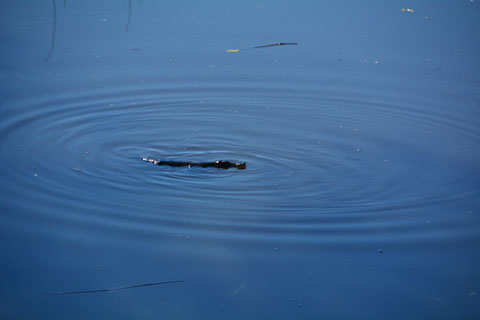When a Platypus's Fancy Turns to Love

For the past few days we've been watching something very special - two platypuses swimming in the same area of our creek. We first spotted them from the living room window on Friday. Straight away we grabbed our cameras and raced down to the creek. And there they were, swimming and duck-diving in the midday sun. So much for the scientists who maintain they're only active at dawn and dusk. Living with them on a day-to-day basis, we know differently.
If you've read MR CHEN'S EMPORIUM or THE JADE WIDOW, you'll know that the platypus is essentially a solitary and independent creature, who spends most of the year on his or her own. It's only in late winter and spring that we ever see two of them in close proximity. Why? Because it's mating time. Afterwards they'll go their separate ways.
The platypus is an amazing animal with a bill and webbed feet like a duck, tiny eyes like a mole, fur like an otter and venom like a snake (in the male's hind spur). In MR CHEN'S EMPORIUM Amy Duncan's little brother has a nasty encounter with a male platypus after trying to dislodge it from its burrow. Serves him right, as far as I'm concerned. I've actually seen two teenage boys beating the banks of the creek with sticks in an attempt to upset the platypus. As they were on the other side of the creek, all I could do was yell at them. I must have given them a fright because they ran away and we haven't seen them since.

As you can see from the picture taken this morning, a platypus will float low in the water and that makes it very difficult to photograph. Unfortunately we didn't manage to get both platypuses in the same shot. You can clearly see the concentric circles of ripples that are often the first sign a platypus is present.
A floating platypus actually looks like a little crocodile, which I suppose reflects its primeval reptilian origins. Egg-laying mammals or 'monotremes', as the scientists call them, are, in fact, the oldest form of mammal. There are only two such species in existence and both live in Australia - the other is the echidna, also known as the spiny anteater.
A platypus can reach quite a speed when it's swimming along the surface - we estimate it can go at about 8 to 10 kilometres an hour, but I just read a reference book which said they can reach speeds of up to 35km an hour! I imagine that would be over a very short distance.
Here is a part of our creek where we often see platypuses. They like to forage among the fallen willow branches.

N.B. There is some debate about the plural of the word 'platypus'. Scientists tend to use the same word for singular and plural - one platypus, two platypus . . . In my books I've used the plural form 'platypuses' because it avoids confusion. I've heard people say 'platypi', but I suspect it's a misguided attempt at a Latin plural. To tell you the truth, it makes me shudder.
Deborah O'Brien
September 23, 2013
